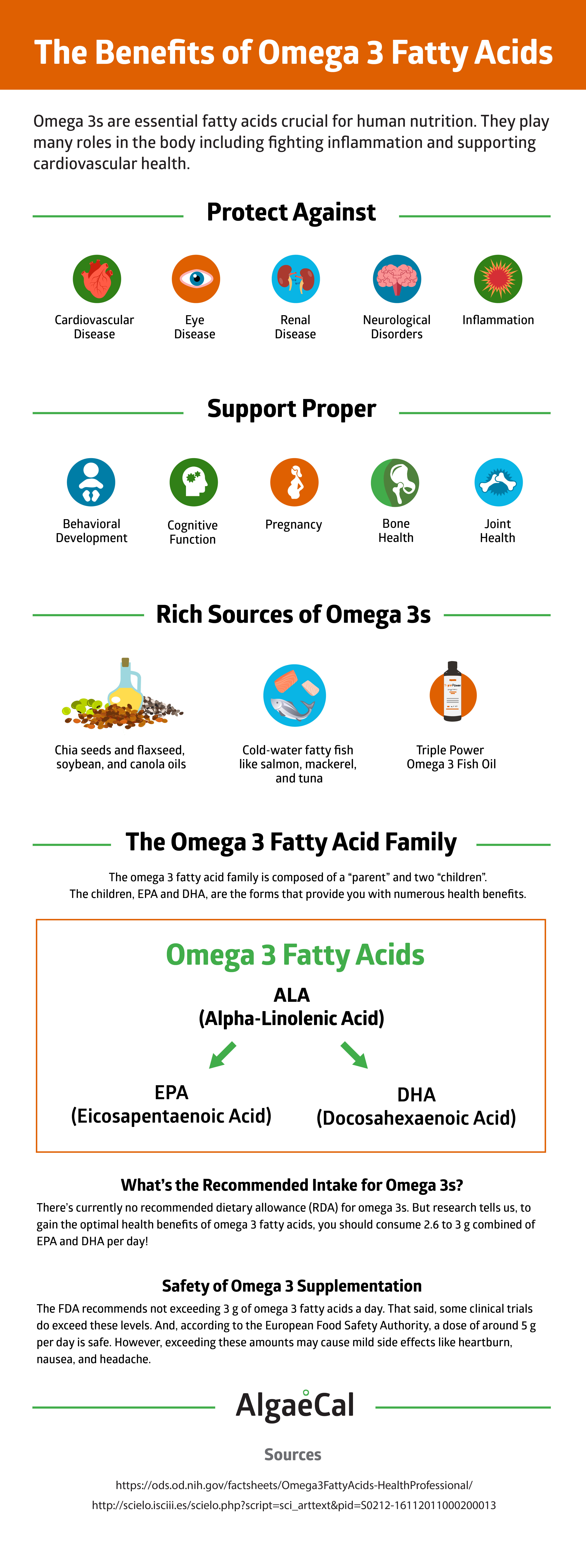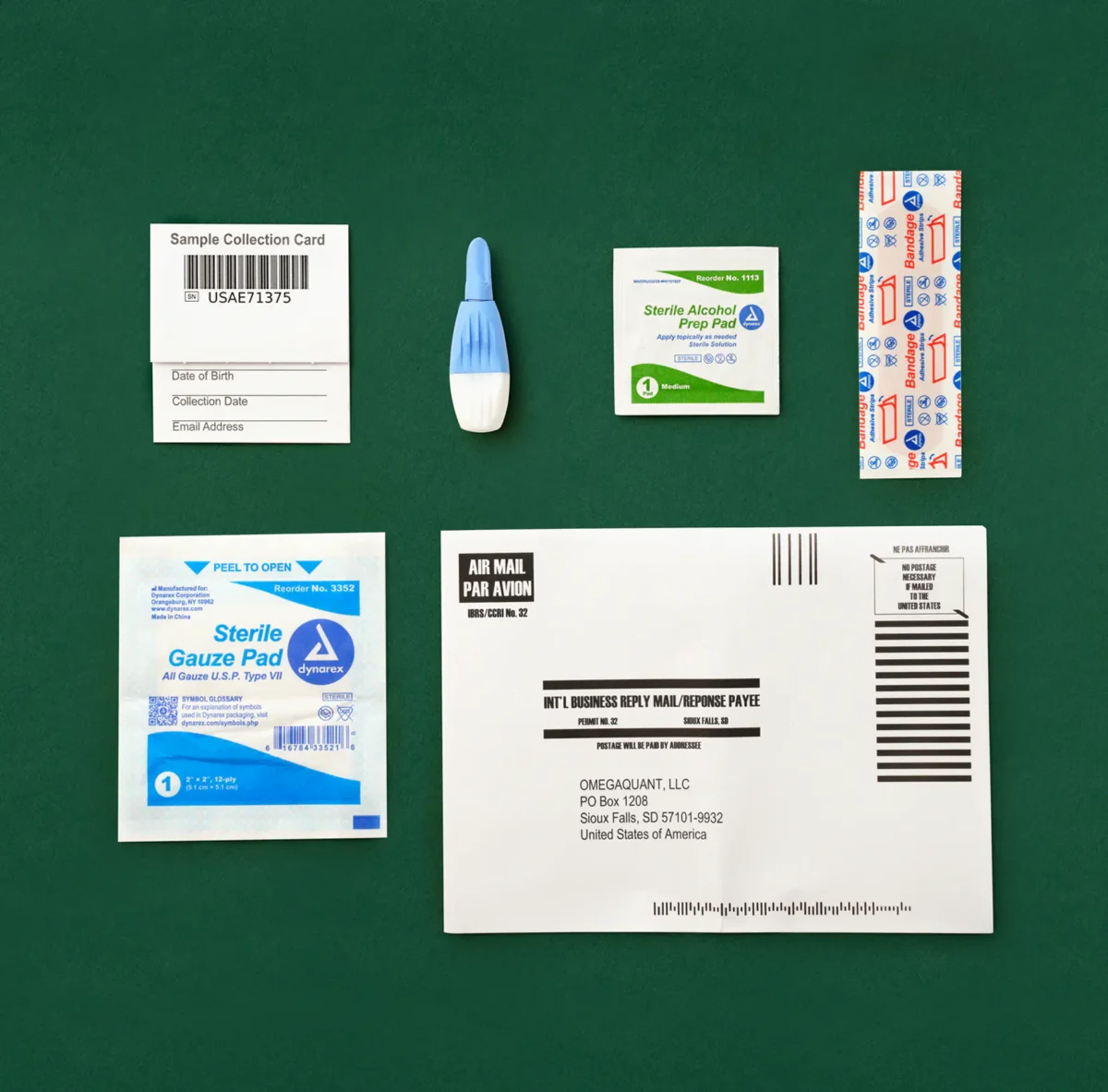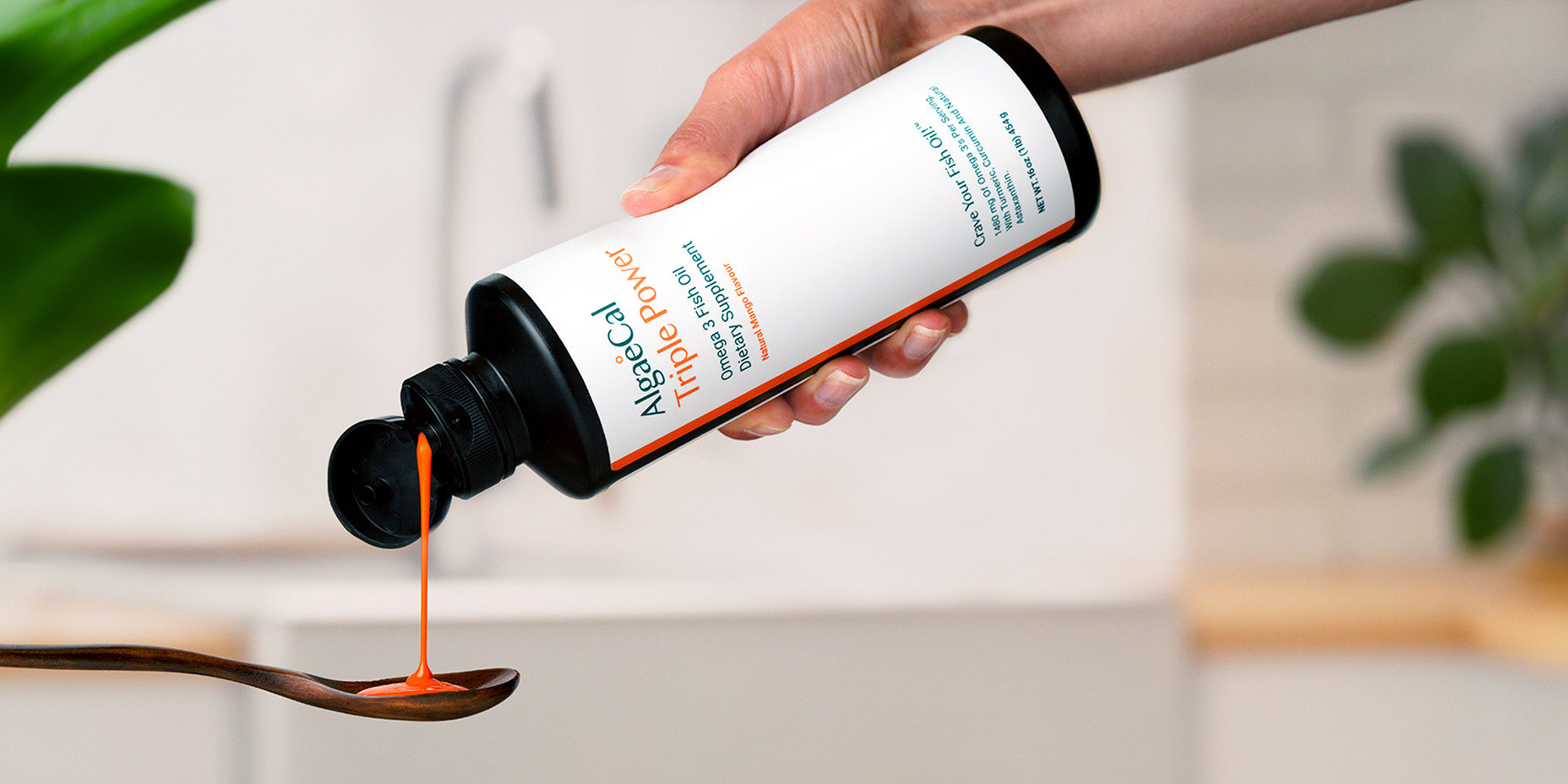Did you know every cell in your body contains omega 3 fatty acids?
They’re an important component of the cell membrane— the outer layer that surrounds a cell.
So, your body’s very foundation, your cells, need omega 3s. It comes as little surprise then, that these essential fatty acids contribute to health in many different ways.
In fact, research shows omega 3 fatty acids benefit everything from cardiovascular health to joint health to cognitive function (to name just a few!).
What’s more, omega 3s play a key role in bone health. They help protect against inflammation, and as you may know, chronic, low-grade inflammation is one of the top causes of osteoporosis.
Yet, omega 3s are severely lacking in the modern western diet (also called the standard American diet or SAD). And just like getting plenty of omega 3s supports many aspects of your health, not getting enough can have the opposite effect.
That said, there’s a certain bodily function that ensures outright deficiency is rare. But even though you’re probably not deficient in the clinical sense, that doesn’t mean you’re getting adequate omega 3s for optimal health.
I’ll explain the truth about omega 3 deficiency (including the function that prevents it!), why you’ll want to test your omega 3 levels anyway, and what to do if it turns out your levels are low a little further down the page!
But first, let’s go over the top health benefits of omega 3s and the flip side of these benefits.
The Top Health Benefits of Omega 3 Fatty Acid
The health benefits of omega 3s have been the focus of a lot of research in recent years.
The biological role of these fatty acids first came to the attention of the scientific community because of an intriguing observation. Scientists noticed that in populations where fish consumption was high, like Japan and Greenland, there was a low rate of coronary heart disease.
Now, fish is a rich source of omega 3s. And as scientists in the Netherlands, Sweden, and the USA discovered, omega 3s play an important role in cardiovascular health!
Since these initial studies, a lot of research has shown omega 3s offer cardiovascular protection. The most compelling evidence for these protective effects comes from a review of three large clinical trials that looked at 32,000 participants in total.
In these trials, participants were randomly assigned to a control group or a test group that received omega 3 fatty acid supplements. And the pooled results from these trials showed a 19-45% reduction in cardiovascular events!
This discovery spurred a ton of research into what other benefits omega 3s might have. Today, there’s a wealth of research on the topic. A quick search for “omega 3 fatty acids” on PubMed– a comprehensive database of scientific research– returns over 27,500 results!
Now, some of the potential health benefits of omega 3s require more study. But there are also several benefits well-backed by research. In addition to cardiovascular health, we know omega 3s can help support:
- Bone health
- Behavioral development
- Cognitive function
- Eye health
- Joint health
- Neurological function
- Pregnancy
- Renal health
 How Omega 3 Fatty Acids Support Your Bone Health
How Omega 3 Fatty Acids Support Your Bone Health
So, omega 3s have a whole host of benefits! And in terms of bone health, they’re absolutely crucial.
As I mentioned briefly earlier, omega 3s fight inflammation. This is key because inflammation has a nasty side effect. It activates osteoclasts— the cells that break down bone in your body.
If inflammation is left unchecked, your osteoclasts start to break down more and more bone. And your osteoblasts, or bone-building cells, can’t keep up! A situation that leads to bone thinning, and ultimately, to osteoporosis.
But omega 3 fatty acids reduce the inflammatory signals telling your osteoclasts to get to work. This buys your bone-building cells time to catch up!
All this to say, omega 3s are an effective tool to fight inflammation and support your bone health.

By now, you’re likely starting to see how important omega 3s are for virtually every aspect of your health. Your bones, your brain, and your heart all rely on these essential fatty acids— not to mention other vital organs like your kidneys and your eyes.
Now, given the benefits we’ve seen, we can reasonably assume not getting enough omega 3s can have the opposite effect.
Take, for example, the review I mentioned earlier that looked into omega 3s and cardiovascular risk. Now, the patients who received omega 3s reduced their risk of a cardiovascular event. But the patients who didn’t receive omega 3s were at increased risk of a cardiovascular event!
If we apply this logic to the other benefits of omega 3s, then we see that low levels can increase your risk of:
- Developing an eye disease
- Developing a renal disease
- Developing a neurological disorder
- Suffering from chronic, low-grade inflammation
- Stunted behavioral development
- Impaired cognitive function
- Pregnancy complications
- Developing low bone density
- Suffering from joint health issues
So, what counts as omega 3 deficiency, and how can you know if you’re getting enough of these essential fatty acids? Keep reading for the answers!
The Truth About Omega 3 Deficiency
When people talk about omega 3 deficiency, what they’re really talking about is omega 3 inadequacy.
Many of us are getting inadequate omega 3s in our diet, but it’s actually almost impossible to be deficient. Why? Because your body won’t allow it!
If you’re not getting enough fats from food or you’re having trouble absorbing fats, your body will compensate by releasing essential fatty acids from adipose-tissue reserves. (Adipose-tissue is simply body fat.)
So, it’s extremely rare to be omega 3 deficient in the clinical sense.
There were a few exceptions back in the 1970s and 1980s. Doctors observed omega 3 deficiency in patients that received nutrition through a feeding tube for a long period of time.
In a study investigating these cases, researchers looked at a total of nine patients who experienced omega 3 fatty acid deficiency. These patients had extensive brain damage and had been fed by a tube for 2.5 to 12 years.
It turns out, the fluid these patients received provided an extremely low amount of omega 3s. So, they developed symptoms like rough, scaly skin, and dermatitis (dermatitis is an inflammation of the skin). Note that these symptoms are consistent with what we know about omega 3s inflammation-fighting power!
Researchers concluded that symptoms of omega 3 deficiency only “occur after a very long time of nearly complete deprivation.” So, it is possible to suffer from omega 3 deficiency. But it takes years of severe deprivation for your body to get to that point!
Of course, today, all fluids provided to patients contain adequate levels of fatty acids to prevent deficiency. So, omega 3 deficiency hasn’t been observed in years.
In fact, the Institute of Medicine Food and Nutrition Board tells us that omega 3 deficiency is non-existent in the USA.
That said, there’s a big difference between not being deficient, and getting adequate omega 3s for optimal health. And inadequacy is quite common.

This is largely because of the modern western diet. As I mentioned earlier, it severely lacks in omega 3s.
What’s worse, this diet is loaded with omega 6s. And omega 6 fatty acids actually do the opposite of omega 3’s— they produce inflammatory compounds! For a more detailed explanation of the difference between omega 3s and omega 6s, you can visit our Omega 3 Fatty Acids and Osteoporosis page.
But in brief, you need a balance of omega 3s and omega 6s, or you’ll produce too many inflammatory compounds, which can cause bone loss.
So, what aspect of the modern western diet is to blame? Well, unless it’s organic, meat like beef, pork, chicken, and turkey is full of omega 6s. This also applies to farmed fish.
The problem is, the feed these animals receive is loaded with bone-damaging omega 6s! This means, if you eat animal products, chances are you’re getting way too many omega 6s.
And that’s bad news for your bones. Don’t worry, though; I’ll cover how to get your omega ratio back up to a healthy range in a moment.
But before you take action, here’s how you can find out if your omega 3 levels are low!
How to Test Your Omega 3 Levels
If you eat a lot of standard animal products, your omega 3 levels could be low, and your omega 6s too high. By standard animal products, I mean animals that aren’t pastured, free-range, or wild-caught.
But if you’re a vegetarian or vegan, your levels could also be low since wild-caught fish is one of the richest sources of omega 3s!
Thankfully, there’s an easy way to find out where you stand for sure.
You can take The Omega 3 Index Test. The National Institutes of Health (NIH) recognize this test as a safe and accurate way of evaluating your omega 3 status. It measures the percentage of omega 3s versus other fats in your blood.
Now, your red blood cells are the same throughout all your tissues. What this means is the omega 3 content of one red blood cell will be the same as every other red blood cell in your body. So, by taking this test, you can find out the omega 3 content of your heart, brain, and all your other organs!
Plus, it’s a simple test to take. You can do it at home in just five minutes. That’s five minutes to find out where your health stands.
If you’re concerned about your bone health, it pays to learn about all six of the top causes of osteoporosis and what you can do to address each one. Chronic, low-grade inflammation is one of these causes, so checking your omega 3 levels is a step towards healthier bones.
And since our goal at AlgaeCal is to support you on your bone health journey in every way possible, we offer OmegaQuant’s test on our website for a lower price than the manufacturer does! For more details, click here.

How to Prevent and Address Low Omega 3 Levels
At the moment, there’s no universal recommendation for daily intake of omega 3s.
Depending on where you live, you may get different information. For example, in France, the recommended intake is 500 mg a day, while in Norway, it’s 1-2 g a day. On the other hand, the American Heart Association (AHA) recommends adults consume wild-caught, fatty fish at least twice a week.
As you can see, advice varies from country to country. But after reviewing the research and recommendations of various government agencies, our Resident Bone Health Expert, Lara Pizzorno, concluded that you should consume between 2.6 to 3 g combined of EPA and DHA a day. (Remember, EPA and DHA are the forms of omega 3 fatty acids that provide health benefits!)
So, how should you go about getting your recommended 3 g of EPA and DHA a day?
Well, the first step should always be nutrition. You can increase your intake by incorporating omega 3-rich foods in your diet. For a list of the top omega 3-rich foods, you can refer to the table on this page.
Just make sure the seafood you include in your diet is wild-caught! As I mentioned earlier, farmed fish is loaded with omega 6s. So, this type of fish can actually do you more harm than good.
This same concept applies to all animal products. Always choose meat and dairy products from pastured animals and free-range chickens to avoid an overload of harmful omega 6s.
That said, it can be difficult to get the full 3 g of omega 3s recommended for optimal health from diet alone. To give you perspective, you’d have to eat at least two 3-ounce portions of wild-caught fish every day to reach this intake. That’s a lot of fish!
And if you’re vegetarian or vegan, your options are even more limited.
The good news is, there’s an easy, convenient, and delicious way to meet your daily omega 3 needs. You can supplement with Triple Power Omega 3 Fish Oil.
Just two tablespoons of Triple Power Omega 3 Fish Oil provides 750 mg of EPA, 450 mg of DHA, and 280 mg of other omega 3 fatty acids for a total of 2.96 g. That’s your recommended daily intake taken care of.
And on top of the inflammation-fighting power of omega 3s, Triple Power contains astaxanthin and curcumin— two of nature’s most potent anti-inflammatories. (Remember, chronic, low-grade inflammation is a common cause of bone loss.)
But the best part about Triple Power is its delicious flavor. You’ll never have to worry about fishy burps or nasty after taste. In fact, the mango flavor is so good that I like to drizzle my Triple Power over my morning granola or yogurt!






Eleida Rodriguez
October 1, 2015 , 7:43 pmHow much